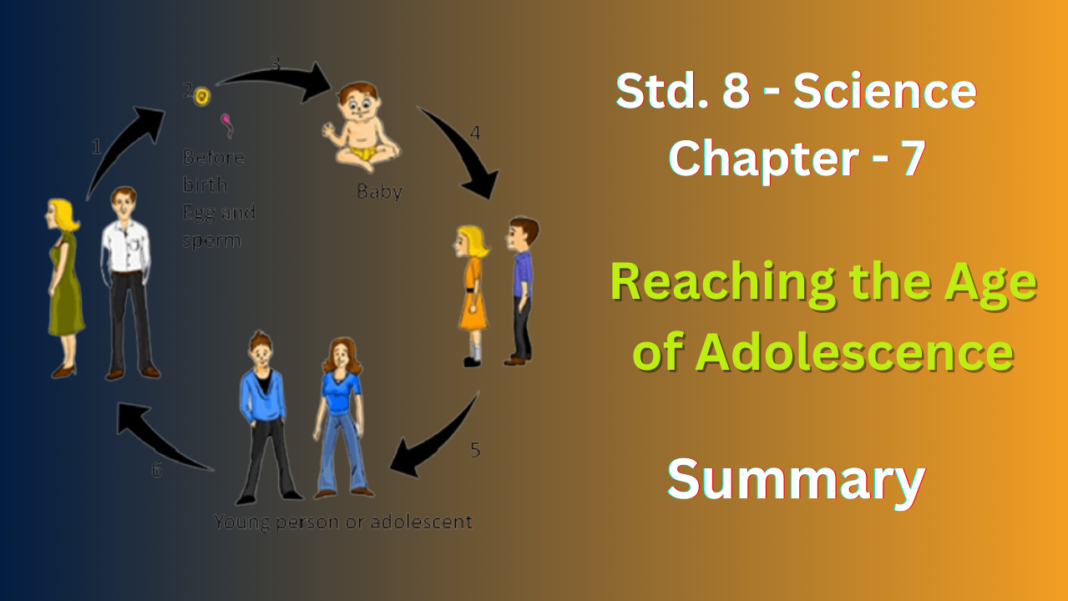NCERT Solutions for Class 8 Science Chapter 7
The chapter “Reaching the Age of Adolescence” talks about a transitional stage in life called adolescence. This is the period between childhood and adulthood, roughly between ages 11 and 19. During adolescence, your body goes through a lot of changes due to a surge in hormones. This is known as puberty.
The chapter discusses some key physical changes during puberty that happen in both boys and girls. These include a sudden growth spurt, changes in voice pitch, and development of body hair. Boys will experience broader shoulders and growth of facial hair, while girls will develop wider hips and breasts. In females, puberty also marks the beginning of menstruation, the monthly shedding of the uterine lining.
Overall, adolescence is a time of great change as your body prepares for reproduction. The chapter emphasizes that this is a normal process and shouldn’t be a cause for worry.
- Adolescence: The period between childhood and adulthood (ages 11-19).
- Puberty: Surge in hormones causing physical changes during adolescence.
- Common changes for both boys and girls:
- Growth spurt
- Voice pitch changes
- Body hair development
- Changes specific to boys:
- Broadening shoulders
- Facial hair growth
- Changes specific to girls:
- Wider hips
- Breast development
- Beginning of menstruation (monthly shedding of uterine lining)
- Adolescence: A normal stage of body preparing for reproduction.
Q. 1. What is the term used for secretions of endocrine glands responsible for changes taking place in the body?
Ans: The term used for these secretions is hormones. Hormones are chemical messengers produced by endocrine glands and travel through the bloodstream to target organs, influencing various functions. During puberty, hormones like estrogen, progesterone, and testosterone play a key role in physical and sexual development.
Q. 2. Define adolescence.
Ans: Adolescence is the transitional period between childhood and adulthood. It’s characterized by rapid physical, emotional, and social changes. The typical age range for adolescence is from 10 to 19 years old, although it can vary depending on the individual.
Q. 3. What is menstruation? Explain.
Ans: Menstruation is the monthly shedding of the lining of the uterus (womb) if pregnancy doesn’t occur. It’s a natural part of the menstrual cycle, which prepares the body for a potential pregnancy each month. Here’s a simplified explanation of the cycle:
Q. 4. List changes in the body that take place at puberty.
Ans: Menstruation is the monthly shedding of the lining of the uterus (womb) if pregnancy doesn’t occur. It’s a natural part of the menstrual cycle, which prepares the body for a potential pregnancy each month. Here’s a simplified explanation of the cycle:
1. Follicular Phase: Hormones stimulate the ovaries to develop follicles, which contain eggs. The lining of the uterus thickens in preparation for a fertilized egg.
2. Ovulation: Around mid-cycle, an egg is released from a mature follicle (ovulation).
3. Luteal Phase: If the egg isn’t fertilized, the follicle left behind disintegrates, and hormone levels drop. This signals the shedding of the uterine lining, which is menstruation.
Question 4. List changes in the body that take place at puberty.
Ans: For Girls:
• Breast development: Breasts start to bud and grow.
• Growth spurt: Increase in height and weight.
• Development of body shape: Hips widen, and body fat distribution changes.
For Boys:
• Testicular enlargement: Testicles grow larger.
• Growth spurt: Increase in height and weight.
• Development of body shape: Broader shoulders and chest.
Q. 5 Prepare a table having two columns depicting names of endocrine glands and hormones secreted by them.
Ans:
| Endocrine Gland | Hormones Secreted |
| Pituitary Gland | Growth hormone (GH) , Thyroid-stimulating hormone (TSH), Adrenocorticotropic hormone (ACTH), Follicle-stimulating hormone (FSH), Luteinizing hormone (LH), Prolactin |
| Thyroid Gland | Thyroxine (T4), Triiodothyronine (T3) |
| Parathyroid Glands | Parathyroid hormone (PTH) |
| Adrenal Glands (two parts: adrenal cortex and adrenal medulla) | Adrenal cortex: Cortisol, Aldosterone, Sex hormones (androgens like testosterone), Adrenal medulla: Adrenaline (epinephrine), Noradrenaline (norepinephrine). |
| Pancreas (also functions as an exocrine gland) | Insulin, Glucagon |
| Ovaries (females) | Oestrogen, Progesterone, Inhibin, Relaxin |
| Testes (males) | Testosterone, Sperm-producing hormones |
| Pineal Gland | Melatonin |
Q. 6. What are sex hormones? Why are they named so? State their function.
Ans: Sex hormones are chemical messengers produced by the gonads (ovaries in females and testes in males) and, in smaller amounts, by the adrenal glands. They are named sex hormones because their primary function is influencing the development and regulation of the reproductive system and sex organs. Here’s a breakdown of their roles:
Functions:
- Development of sexual characteristics: During puberty, sex hormones trigger the growth and maturation of secondary sex characteristics. In females, this includes breast development, widening of hips, and changes in body fat distribution. In males, it includes facial hair growth, voice deepening, and muscle development.
- Regulation of the reproductive system: Sex hormones play a crucial role in maintaining the menstrual cycle in females and sperm production in males.
- Sexual desire and function: Sex hormones influence libido (sex drive) and sexual function in both males and females.
- Other functions: Sex hormones also have various other effects on the body, including bone health, metabolism, and mood regulation.
Q. 7 Choose the correct option.
(a) Adolescents should be careful about what they eat, because:
(i) proper diet develops their brains.
(ii) proper diet is needed for the rapid growth taking place in their body.
(iii) adolescents feel hungry all the time.
(iv) taste buds are well developed in teenagers.
Ans: (ii) proper diet is needed for the rapid growth taking place in their body.
(b) Reproductive age in women starts when their:
(i) menstruation starts.
(ii) breasts start developing.
(iii) body weight increases.
(iv) height increases.
Ans: (i) menstruation starts.
(c) The right meal for adolescents consists of:
(i) chips, noodles, coke.
(ii) chapati, dal, vegetables.
(iii) rice, noodles and burger.
(iv) vegetable cutlets, chips and lemon drink.
Ans: (ii) chapati, dal, vegetables.
Question 8.
Write notes on:
(a) Adam’s apple
Ans: The Adam’s apple is the noticeable protrusion on the front of some people’s throats. It’s made of cartilage and it protects your voice box, also known as the larynx. Everyone has this cartilage, but it’s not always visible. The medical term for Adam’s apple is “laryngeal prominence.”
The Adam’s apple is typically larger in people assigned male at birth (AMAB) than people assigned female at birth (AFAB). This is due to hormonal changes during puberty. Testosterone, the main male sex hormone, causes the vocal cords to lengthen and thicken, which in turn makes the Adam’s apple more prominent.
It’s important to note that the size of Adam’s apple can vary among individuals, and it doesn’t necessarily correlate with masculinity or femininity.
(b) Secondary sexual characters.
Ans: Secondary sexual characteristics are physical features that appear during puberty or sexual maturity that differentiate between sexes but aren’t directly involved in reproduction. In humans, these develop around the ages of 10-14 for females and 12-16 for males, though there can be variations.
Here are some examples of secondary sexual characteristics in humans:
- Males:
- Growth of facial hair (beard, moustache)
- Deepening of the voice due to a larger larynx (Adam’s apple)
- Increased muscle mass and strength
- Broadening of the shoulders and chest
- Increased body hair growth (chest, pubic, underarms)
- Females:
- Development of breasts
- Widening of the hips
- Growth of body hair (pubic, underarms)
- Changes in body fat distribution
These secondary sexual characteristics are influenced by sex hormones like testosterone in males and oestrogen in females.
(c) Sex determination in the unborn baby.
Ans: The sex of a baby is actually determined at the moment of fertilisation, when a sperm fertilises an egg. Here’s the breakdown:
Chromosomes:
- Humans have 23 pairs of chromosomes, totaling 46 chromosomes.
- Out of these 23 pairs, one pair is called the sex chromosomes (XX for females, XY for males).
The Egg and Sperm:
- Eggs from females always carry an X chromosome.
- Sperm from males can carry either an X or a Y chromosome.
The Big Decision:
- If the sperm fertilises the egg with an X chromosome, the baby will be XX (female).
- If the sperm fertilises the egg with a Y chromosome, the baby will be XY (male).
So, it all depends on the sperm! The father determines the sex of the baby based on whether the sperm carries an X or Y chromosome.
Q.9 Word game: Use the clues to work out the words.
Across:
3. Protruding voice box in boys
4. Glands without ducts
7. Endocrine gland attached to brain
8. Secretion of endocrine glands
9. Pancreatic hormone
10. Female hormone
Down:
1. Male hormone
2. Secretes thyroxine
3. Another term for teenage
5. Hormone reaches here through blood stream
6. Voice box
7. Term for changes at adolescence
Ans: Across:
- ADAM’S APPLE
- ENDOCRINE GLANDS
- PITUITARY
- HORMONE
- INSULIN
- ESTROGEN
Down:
- TESTOSTERONE
- THYROID
- ADOLESCENCE
- TARGET SITE
- LARYNX
- PUBERTY
Q10. The table below shows the data on likely heights of boys and girls as they grow in age. Draw graphs showing height and age for both boys and girls on the same graph paper. What conclusions can be drawn from these graphs?Ans:
FAQ’s
What topics are covered in NCERT Solutions for Class 8 Science Chapter 7?
The chapter covers various aspects of adolescence, including physical changes, emotional development, reproductive health, and adolescent issues.
How can NCERT Solutions help in understanding adolescence better?
NCERT Solutions provide detailed explanations and insights into the changes that occur during adolescence, helping students understand the physical and emotional aspects of this phase.
Are there specific sections in the chapter that focus on reproductive health?
Yes, the chapter includes sections dedicated to discussing reproductive health, puberty, and the changes associated with it.
Do NCERT Solutions offer practical advice for adolescents?
Yes, along with theoretical explanations, NCERT Solutions often include practical tips and advice for adolescents to navigate through this phase of life.
Can NCERT Solutions help in addressing common concerns related to adolescence?
Absolutely! NCERT Solutions address common concerns and queries that adolescents may have about their changing bodies, emotions, and relationships, providing guidance and support.









